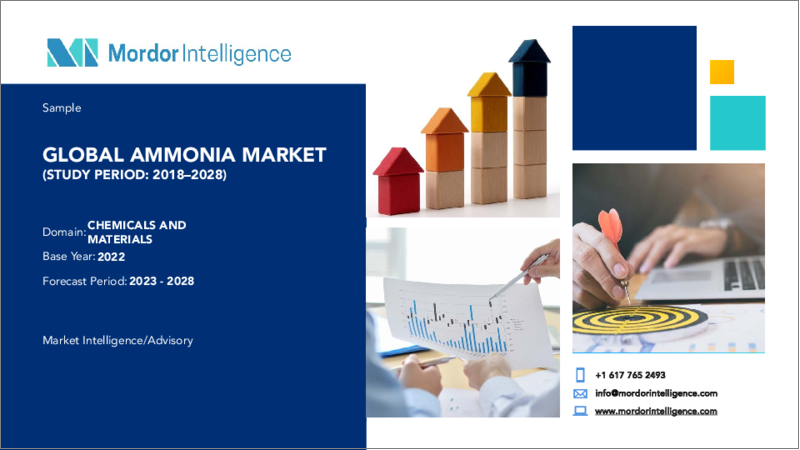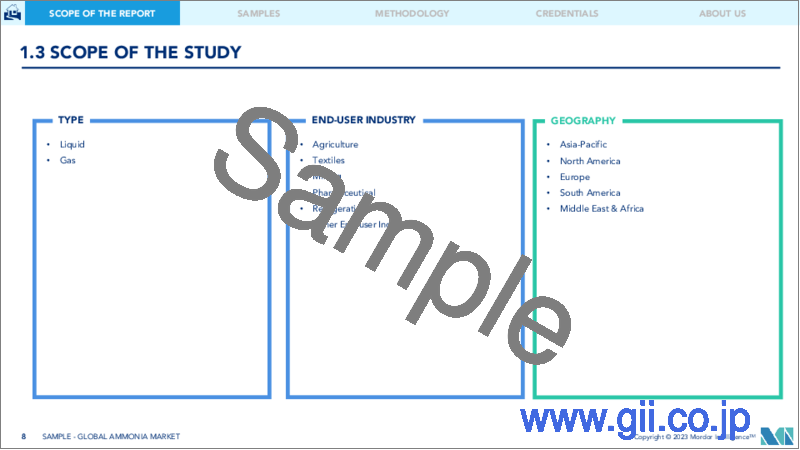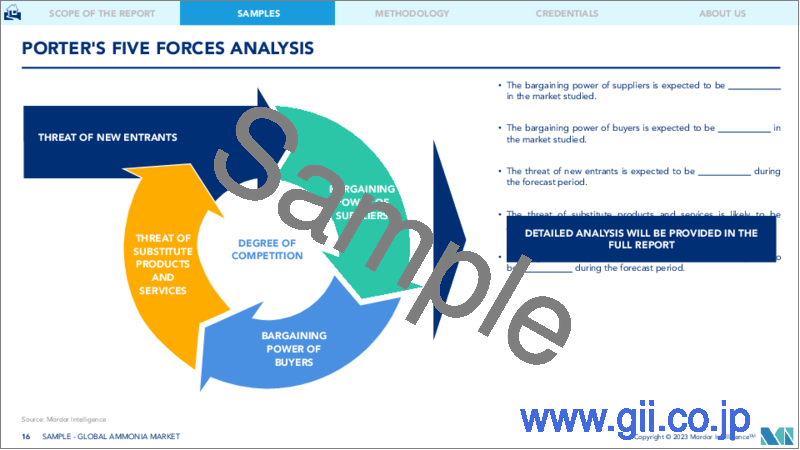|
|
市場調査レポート
商品コード
1189789
アンモニア市場- 成長、動向、予測(2023年-2028年)Ammonia Market - Growth, Trends, and Forecasts (2023 - 2028) |
||||||
|
● お客様のご希望に応じて、既存データの加工や未掲載情報(例:国別セグメント)の追加などの対応が可能です。 詳細はお問い合わせください。 |
|||||||
| アンモニア市場- 成長、動向、予測(2023年-2028年) |
|
出版日: 2023年01月18日
発行: Mordor Intelligence
ページ情報: 英文 140 Pages
納期: 2~3営業日
|
- 全表示
- 概要
- 目次
アンモニア市場は、予測期間中に2%を超えるCAGRで推移すると予想されています。
COVID-19のパンデミックの間、農業、繊維、鉱業、その他のエンドユーザー産業が大きな影響を受けたため、世界的にアンモニア市場にマイナスの影響がありました。しかし、医薬品セグメントの成長は業界で改善されており、市場開拓を支援することになるでしょう。現在、アンモニア市場はパンデミックから回復し、大きく成長しています。
主なハイライト
- 短期的には、農業分野での需要の高まりと、火薬の製造におけるアンモニアの使用量の増加が、予測期間を通じて市場の成長を促進すると予測されます。
- しかし、濃縮された状態のアンモニアがもたらす危険な作用が、市場成長の妨げになる可能性があります。
- しかし、冷媒としてのアンモニアの利用は、予測期間中、市場にとって好機となる可能性があります。
- 世界全体ではアジア太平洋地域が市場を独占しており、中国やインドなどの国々が最も多く消費しています。
主な市場動向
市場を独占する農業分野
- アンモニアは、NH3として知られ、植物の成長に非常に効果的で頻繁に利用される窒素源です。アンモニアの用途は非常に単純であり、豊富に入手できることから、肥料としての利用が拡大しています。アンモニアは硝酸アンモニウム肥料の基本成分で、農作物や芝生などの植物育成に欠かせない窒素を生成します。また、一般的な窒素肥料に加工されることもあります。
- 米国地質調査所(United States Geological Survey)によると、アンモニアの生産量は近年、むしろ堅調に推移しています。世界のアンモニア生産量は2021年に1億5000万トンに達しています。東アジアが最も多くのアンモニアを生産し、約6460万トンが生産されました。中国は単独で2021年に約3900万メートルトンのアンモニアを生成し、アンモニア生産国の世界ランキングで1位となっています。
- 世界のアンモニア市場は農業が支配的であり、推定市場シェアは80%以上です。アンモニアは主に肥料に使用され、長年にわたり一貫して用途を拡大してきたため、予測期間中は農業分野での使用が加速されます。
- 肥料は、農業の発展に必要な植物の栄養分です。農業生産が増加するにつれて、肥料産業も発展していくと思われます。肉、乳製品、魚、菓子、果物、野菜の消費は、穀物の消費よりも早く増加しています。
- 尿素は、アンモニアと二酸化炭素を結合してできる乾燥窒素物質です。使用頻度の高い乾式肥料の中で、最も窒素含有量が多いです。近年、硝酸アンモニウムに代わって急速に普及しつつあります。
- 中国国家統計局によると、中国の農業総生産額は2020年の13兆8,000億元(1兆9,000億米ドル)に対し、2021年には約14兆7,000億元(2兆1,000億米ドル)となっています。
- インド経済統計局(DES)によると、2021年度のインドにおける食用穀物の農業生産額の指標数値は約141となり、前年の約139.8から上昇しました。同国では、米、小麦、トウモロコシ、豆類が主要な食用穀物として生産されています。
- 米国農務省によると、サウジアラビアへの農産物輸出額は、2020年の12億米ドルに対し、2021年には約13億米ドルとなっています。
- 前述のすべての要因が農業分野を牽引し、予測期間中のアンモニア需要を高めると予想されます。
アジア太平洋地域が市場を独占する
- アジア太平洋地域は、市場シェアと市場収益の面で、アンモニア市場の中でも突出したシェアを誇っています。この地域は、予測期間中、その優位性を維持し続けるものと思われます。
- 中国は、世界全体の農業面積の約7%を占め、世界人口の22%に給餌しています。そのため、大規模な農業活動が行われており、肥料として使用されるアンモニアの需要が急増しています。
- 中華人民共和国税関総署によると、2021年の中国における農産物の輸入は28.6%増加し、総額約844億米ドルとなりました。過去15年間、中国への農産物輸入は輸出を上回るペースで伸びています。
- インドでは、2020-21年の主要作物インドは、2019-20年に達成した食用穀物の生産量を584万トン上回る3億334万トンの記録的な生産量を管理しました。
- インドは2023年までに、医薬品原料を国内で製造する企業を後押しするため、約100億インドルピー(121億1000万米ドル)の基金を設立する計画です。
- 農林水産省・統計局によると、日本への農林水産物の輸入額は、2020年の8兆9,000億円(6726万米ドル)に対し、2021年には約10兆円(7557万米ドル)となっています。
- 東南アジア諸国連合(ASEAN)には、タイ、インドネシア、ベトナム、フィリピン、マレーシア、シンガポール、ミャンマー、カンボジア、ラオス、ブルネイが含まれます。東南アジア諸国連合(ASEAN)のマクロ経済の状況は、今後数年間、力強い成長を予測させるようです。
- したがって、上記のすべての要因は、予測期間中にアンモニア市場の需要増加をもたらすと思われます。
競合情勢
アンモニア市場は断片的であり、さまざまな地域の国際的および地域的なプレーヤーが含まれています。市場の主要メーカー(順不同)には、CF Industries Holdings Inc.、Yara、Nutrien Ltd、OCI Nitrogen、Ostchem(Group DF)などがあり、その他の有力メーカーもそれに続いています。
その他の特典
- エクセル形式の市場予測(ME)シート
- アナリストによる3ヶ月間のサポート
目次
第1章 イントロダクション
- 調査の前提条件
- 調査範囲
第2章 調査手法
第3章 エグゼクティブサマリー
第4章 市場力学
- 促進要因
- 農業分野での豊富な使用量
- 火薬の生産における使用量の増加
- 抑制要因
- 濃縮された状態での危険な影響
- その他の制約
- 産業バリューチェーン分析
- ポーターのファイブフォース分析
- 供給企業の交渉力
- 買い手の交渉力
- 新規参入業者の脅威
- 代替品の脅威
- 競合の度合い
第5章 市場セグメンテーション(市場規模・数量ベース)
- 種類
- 液体
- ガス
- エンドユーザー産業
- 農業分野
- 繊維
- 鉱業
- 製薬
- 冷凍
- その他のエンドユーザー産業
- 地域別
- アジア太平洋地域
- 中国
- インド
- 日本
- 韓国
- その他アジア太平洋地域
- 北米
- 米国
- カナダ
- メキシコ
- 欧州
- ドイツ
- 英国
- イタリア
- フランス
- その他欧州
- 南米
- ブラジル
- アルゼンチン
- その他の南米地域
- 中東・アフリカ地域
- サウジアラビア
- 南アフリカ
- その他中東・アフリカ地域
- アジア太平洋地域
第6章 競合情勢
- M&A、ジョイントベンチャー、共同、契約書
- 市場ランキング分析
- リーディングプレイヤーが採用する戦略
- 企業プロファイル
- BASF SE
- CASCALE SA
- CF Industries Holdings Inc.
- Chambal Fertilisers and Chemicals Ltd
- CSBP Limited
- EuroChem Group
- Group DF(OSTCHEM)
- Indian Farmers Fertiliser Cooperative Limited(IFFCO)
- Koch Fertilizer LLC
- Nutrien Ltd
- OCI Nitrogen
- PJSC Togliattiazot(TOAZ)
- Qatar Fertiliser Company
- Rashtriya Chemicals and Fertilizers Limited
- SABIC
- Yara
第7章 市場機会と将来動向
- 冷媒としてのアンモニア利用
The ammonia market is anticipated to register a CAGR of greater than 2% during the forecast period.
During the COVID-19 pandemic, there has been a negative impact on the ammonia market globally as agriculture, textile, mining, and other end-user industries were significantly affected. However, growth in the pharmaceutical segment is improving in the industry, which would assist the market development. Currently, the ammonia market has recovered from the pandemic and is growing significantly.
Key Highlights
- Over the short term, growing demand in the agriculture industry and ammonia's increasing usage for the production of explosives are projected to fuel market growth throughout the forecast period.
- However, the hazardous effects of ammonia in its concentrated form are likely to hinder the growth of the market.
- Nevertheless, the use of ammonia as a refrigerant is likely to act as an opportunity for the market during the forecast period.
- Asia-Pacific dominated the market across the world, with the largest consumption from countries such as China and India.
Key Market Trends
Agriculture Segment to Dominate the Market
- Ammonia, often known as NH3, is a highly effective and frequently utilized nitrogen source for plant development. Ammonia's very straightforward application and abundant availability have resulted in its expanded usage as a fertilizer. Ammonia is a fundamental component of ammonium nitrate fertilizer, which produces nitrogen, a vital ingredient for growing plants such as farm crops and lawns. It may also be turned into a range of typical N fertilizers.
- According to United States Geological Survey, ammonia production has been rather steady in recent years. Global ammonia output has reached 150 million metric tons in 2021. East Asia produced the most ammonia, with around 64.6 million metric tons produced. China alone generated around 39 million metric tons of ammonia in 2021, placing it first in the world's ranking of ammonia-producing countries.
- Agriculture dominates the global ammonia market, with an estimated market share of more than 80%. Ammonia is largely used in fertilizers and has consistently expanded in use over the years, accelerating its use in the agricultural sector during the forecast period.
- Fertilizers are plant nutrients that are necessary for agricultural development. With agricultural production increasing over time, the fertilizer industry is likely to develop as well. Consumption of meat, dairy products, fish, sweets, fruits, and vegetables has increased faster than consumption of grains.
- Urea is a dry nitrogen substance that is created by combining ammonia and carbon dioxide. It has the greatest nitrogen content of any frequently used dry fertilizer. In recent years, it has been quickly replacing ammonium nitrate.
- According to the National Bureau of Statistics of China, the gross production value of agricultural industries in China amounted to around CNY 14.7 trillion (USD 2.1 trillion) in 2021, compared to CNY 13.8 trillion (USD 1.9 trillion) in 2020.
- According to the Directorate of Economics and Statistics (DES) India, in the fiscal year 2021, the index number of agricultural output for food grains in India was about 141, up from approximately 139.8 in the previous fiscal year. Rice, wheat, maize, and pulses are the principal food grains produced in the nation.
- According to the United State Department of Agriculture, the value of agricultural exports to Saudi Arabia stood at about USD 1.3 billion in 2021, compared to USD 1.2 billion in 2020.
- All the aforementioned factors are expected to drive the agricultural segment, enhancing the ammonia demand during the forecast period.
Asia-Pacific Region to Dominate the Market
- Asia-Pacific holds a prominent share of the ammonia market in terms of market share and market revenue. The region is set to continue to flourish in its dominance over the forecast period.
- China, accounts for approximately 7% of the overall agricultural acreage globally, thus feeding 22% of the world population. Hence, the demand for ammonia, which is used as a fertilizer, is rapidly increasing due to the large-scale agricultural activities in the country.
- According to the General Administration of Customs of the People's Republic of China, imports of agricultural products in China increased by 28.6% in 2021, totaling around USD 84.4 billion. Over the previous 15 years, agricultural imports to China have grown at a faster rate than exports.
- In India, for the year 2020-21, key crops India managed a record output of 303.34 million tons of food grains, 5.84 million tonnes more than the production of foodgrains attained in 2019-20.
- India plans to set up a fund of nearly INR 1 lakh crore (USD 12.11 billion) to provide a boost to companies to manufacture pharmaceutical ingredients domestically by 2023.
- According to the Ministry of Agriculture, Forestry and Fisheries (MAFF) and Statistics Bureau of Japan, the import value of agricultural, forestry, and fishery commodities to Japan amounted to around JPY 10 trillion (USD 75.57 million) in 2021, compared to JPY 8.9 trillion (USD 67.26 million) in 2020.
- The Association of Southeast Asian Nations (ASEAN) includes Thailand, Indonesia, Vietnam, the Philippines, Malaysia, Singapore, Myanmar, Cambodia, Laos, and Brunei. The macroeconomic condition of the Association of Southeast Asian Countries (ASEAN) seems to project strong growth in the coming years.
- Thus, all the above-mentioned factors are likely to provide the increasing demand for the ammonia market during the forecast period.
Competitive Landscape
The ammonia market is fragmented, with the inclusion of international and local players in different regions. The major manufacturers in the market (in no particular order) include CF Industries Holdings Inc., Yara, Nutrien Ltd, OCI Nitrogen, and Ostchem (Group DF), followed by other prominent players.
Additional Benefits:
- The market estimate (ME) sheet in Excel format
- 3 months of analyst support
TABLE OF CONTENTS
1 INTRODUCTION
- 1.1 Study Assumptions
- 1.2 Scope of the Study
2 RESEARCH METHODOLOGY
3 EXECUTIVE SUMMARY
4 MARKET DYNAMICS
- 4.1 Drivers
- 4.1.1 Abundant Use in the Agriculture Industry
- 4.1.2 Increasing Usage for the Production of Explosives
- 4.2 Restraints
- 4.2.1 Hazardous Effects in its Concentrated Form
- 4.2.2 Other Restraints
- 4.3 Industry Value Chain Analysis
- 4.4 Porter's Five Forces Analysis
- 4.4.1 Bargaining Power of Suppliers
- 4.4.2 Bargaining Power of Buyers
- 4.4.3 Threat of New Entrants
- 4.4.4 Threat of Substitute Products and Services
- 4.4.5 Degree of Competition
5 MARKET SEGMENTATION (Market Size in Volume)
- 5.1 Type
- 5.1.1 Liquid
- 5.1.2 Gas
- 5.2 End-user Industry
- 5.2.1 Agriculture
- 5.2.2 Textiles
- 5.2.3 Mining
- 5.2.4 Pharmaceutical
- 5.2.5 Refrigeration
- 5.2.6 Other End-user Industries
- 5.3 Geography
- 5.3.1 Asia-Pacific
- 5.3.1.1 China
- 5.3.1.2 India
- 5.3.1.3 Japan
- 5.3.1.4 South Korea
- 5.3.1.5 Rest of Asia-Pacific
- 5.3.2 North America
- 5.3.2.1 United States
- 5.3.2.2 Canada
- 5.3.2.3 Mexico
- 5.3.3 Europe
- 5.3.3.1 Germany
- 5.3.3.2 United Kingdom
- 5.3.3.3 Italy
- 5.3.3.4 France
- 5.3.3.5 Rest of Europe
- 5.3.4 South America
- 5.3.4.1 Brazil
- 5.3.4.2 Argentina
- 5.3.4.3 Rest of South America
- 5.3.5 Middle-East and Africa
- 5.3.5.1 Saudi Arabia
- 5.3.5.2 South Africa
- 5.3.5.3 Rest of Middle-East and Africa
- 5.3.1 Asia-Pacific
6 COMPETITIVE LANDSCAPE
- 6.1 Mergers, Acquisitions, Joint Ventures, Collaborations, and Agreements
- 6.2 Market Ranking Analysis
- 6.3 Strategies Adopted by Leading Players
- 6.4 Company Profiles
- 6.4.1 BASF SE
- 6.4.2 CASCALE SA
- 6.4.3 CF Industries Holdings Inc.
- 6.4.4 Chambal Fertilisers and Chemicals Ltd
- 6.4.5 CSBP Limited
- 6.4.6 EuroChem Group
- 6.4.7 Group DF (OSTCHEM)
- 6.4.8 Indian Farmers Fertiliser Cooperative Limited (IFFCO)
- 6.4.9 Koch Fertilizer LLC
- 6.4.10 Nutrien Ltd
- 6.4.11 OCI Nitrogen
- 6.4.12 PJSC Togliattiazot (TOAZ)
- 6.4.13 Qatar Fertiliser Company
- 6.4.14 Rashtriya Chemicals and Fertilizers Limited
- 6.4.15 SABIC
- 6.4.16 Yara
7 MARKET OPPORTUNITIES AND FUTURE TRENDS
- 7.1 Use of Ammonia as a Refrigerant




